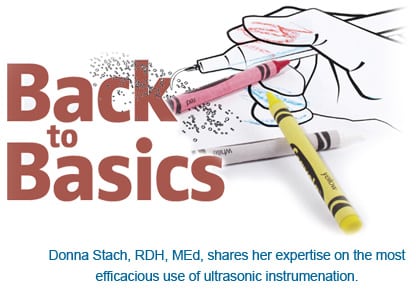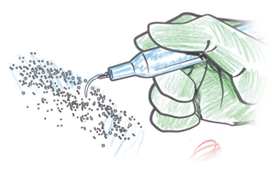
Back to Basics
Donna Stach, RDH, MEd, talks about the most efficacious use of ultrasonic instrumentation.
Q. Do you think that a blended approach is the most effective?
A. Yes, I generally think that using ultrasonic and hand instrumentation together provides better results. I feel that ultrasonic instrumentation is well-accepted as a parallel method for nonsurgical periodontal treatment or maintenance. The American Academy of Periodontology (AAP) position paper on sonic and ultrasonic scalers and periodontics begins with, “Ultrasonic and sonic scalers appear to attain similar results as hand instruments for the removal of plaque, calculus, and endotoxin.”1 As a profession, I think we should try to lay this question to rest and go back to the basics.
First, an in-depth patient assessment should be completed where the patient’s periodontal condition, pocket depth, and bleeding on probing, which is the window into inflammation, are all noted. Then the dental hygienist can proceed to treatment planning and deciding what the challenge is that needs to be resolved and which modality will accomplish the goal most effectively. It’s only when the problem is understood that treatment decisions can be made. Some dental hygienists seem to be looking for a one-size fits all type of treatment. Instead, I think we should try to be good diagnosticians of the problems we’re trying to solve.
Q. Are there myths existing today regarding ultrasonics?
A. In dental hygiene today, ultrasonic instrumentation tends to be thought of as magic. This is a misunderstanding. Instrumenting deep pockets is difficult. Another false notion is that when the ultrasonic tip is moved back and forth a few times in a deep pocket that the action of the water creates adequate instrumentation. The literature does not support this. Biofilm is only removed where the instrument tip contacts the tooth and a narrow band next to it. Thorough instrumentation requires taking quite a number of strokes and making contact with all the different areas of the tooth.
Another myth is that ultrasonic instrumentation is more effective because it’s faster. When removing biofilm, a rapid stroke is used but rapid strokes are effective only with good adaptation and when contact is made on all facets of the tooth.
THE STROKE
Q. What type of stroke should be used with ultrasonic instrumentation?
A. With biofilm, dental hygienists can take faster strokes than with heavier calculus where slower strokes are more effective. Heavy calculus breaks up with the ultrasonic action, by putting little microfractures in the deposit, and so the tip needs to be on the surface for some time in order to allow the microfractures to develop. When large pieces of calculus are present that have been there for awhile, slower strokes seem to be more effective. And when the tip is directly on the tenacious calculus deposits, maximum power should be used. The majority of the power is concentrated on the point of the tip.
 In my experience, ultrasonics can burnish heavy calculus especially with rapid wiping motions. This should be avoided because removing a burnished deposit is much more difficult than removing it initially. Once it’s glassy smooth, the calculus is difficult to find and difficult to remove.
In my experience, ultrasonics can burnish heavy calculus especially with rapid wiping motions. This should be avoided because removing a burnished deposit is much more difficult than removing it initially. Once it’s glassy smooth, the calculus is difficult to find and difficult to remove.
TIPS
Q. What is the most widely used tip in practice?
A. As I understand, the dominant tip is the straight slim style tip, which is the tip for prophylaxis. It is used on a healthy mouth, in shallow pockets, for very light deposits, and on low-power.
Using a variety of tips and instruments that adapt to tooth contours is key to effective instrumentation. Using only one ultrasonic tip like using one hand instrument is not as effective.
When access to deeper areas is necessary, a contralateral tip (right or left slim style tip) can be used, positioning it parallel to the long axis of the tooth so that it can fit into deep areas much like a periodontal probe. Using a contralateral tip is not easy—it takes finesse, technique, skill, and time to instrument all of the root anatomy that is present in deep pockets.
Q. What tip is used for moderate calculus?
A. If the calculus is coming off fairly easily, then a slim style tip can be used. But when heavier calculus is encountered that is well-established and difficult to remove, a gross scaling tip on higher power is needed. For heavy calculus, a tip must have some significant movement against the calculus or it just won’t come off. The heavier the calculus, the more power and time that are needed in order to be successful.
Q. What are the limitations of a slim style tip?
A. With many slim tips, the power cannot be turned on high enough to fracture heavy calculus deposits. If the power is cranked up, some slim style tips may break. The thinness of the tip causes large movement (amplitude) when on high power, which can also be uncomfortable for the patient.
Let’s use an analogy with hand instruments. When hand instruments are used to remove biofilm, light lateral pressure is ideal because it increases patient comfort and is still effective. But if a heavy or hard deposit is encountered, more lateral pressure is needed to remove it and we want to take it off in the largest pieces possible. What can happen with light lateral pressure on a heavy deposit is that the surface is shaved off until it feels smooth but the deposit still has not been removed, which creates an inflammatory response. This translates to ultrasonics in that the slim tips/low power combination is great for light calculus and biofilm removal. These tips reach a lot of places and they’re comfortable. With heavier tenacious deposits, a tip with higher power provides the much firmer vibratory action against the tooth that is needed to avoid burnishing.
Q. What technique should be used for burnished calculus?
A. For burnished (black) calculus, the focused energy of the tip needs to be used. The tip should be moving around and working over the surface without any kind of tapping action. The power must be focused on that calculus because this will put tiny microfractures in the calculus from the mechanical vibratory action. Also, only the last millimeters of the tip should be used. A common error when using ultrasonics is to work in the middle of the tip. The most energy is available when only the last millimeters are used.
Q. Does low-powered ultrasonic instrumentation remove calculus or is it more likely to just burnish it?
A. I think if it’s well-established calculus, low-powered instrumentation just knocks off the top layers and burnishes it. If the patient is on a 3-month maintenance visit with mostly new supragingival, nontenacious calculus, low power is likely effective.
A huge issue with ultrasonic scaling is the tendency to burnish calculus and not realize it’s still there. This often doesn’t show up until a maintenance visit when the area still bleeds. My experience is that if pockets are bleeding at maintenance visits, odds are that calculus is still present.
Good decision making leads to effective instrumentation. Once calculus is burnished, the clinician needs to change technique, use higher power with bigger tips, or move to hand instruments. 
Q. When, if ever, is it acceptable to use only ultrasonic scaling without any hand instrumentation?
A. Clinicians can develop excellent ultrasonics skills. I think the real key is not so much which instruments are used, but rather what the results are. If patients are coming back and they have returned to a state of health—they’re not bleeding, they don’t show signs of inflammation—this is the ultimate criteria of success. If clinicians can accomplish this with ultrasonics, then great. I think most clinicians need to use a combination of hand and ultrasonic instrumentation in order to get all of the difficult to reach deposits.
Q. Some clinicians believe that leaving burnished calculus on the roots is not detrimental if you can bring the patient back for ultrasonic low powered debridement every 3 months to “keep the pathogens down.” If burnished calculus is left on the roots, do you think that low powered ultrasonic debridement on a 3 month maintenance schedule is enough to control periodontal disease or prevent breakdown?
A. In my clinical experience, areas where there is residual calculus, ie, burnished calculus, rarely return to a state of health. My experience is that these areas are almost always still bleeding. And when the pocket is bleeding, then I don’t think any amount of deplaquing every 3 months is going to get the patient back to health. Thorough removal of the deposits, plaque, calculus, and endotoxin, is what’s necessary. I recently treated a patient who had been in for scaling and root planing and for several 3-month maintenance visits who had about four or five deep pockets that just bled and bled. As I assessed and explored, a layer of calculus was found at the bottom of all pockets. It took two visits to retreat with local anesthesia and ultrasonic and hand instrumentation but when the patient returned in 3 months nothing bled.
Q. Is it acceptable to leave small pieces of burnished calculus as long as the biofilm on the surface of the calculus is removed?
A. Theoretically I would say no but practically I would say that we need to look at whether the patient is exhibiting any signs of bleeding or inflammation. Calculus seems to be a focal point of bacterial repopulation so if we can remove it I think we should. These small pieces of burnished calculus are often in small grooves or depressions in the roots or in deep or narrow pockets so they are truly difficult to identify and remove. But we know that inflammation is closely associated with the presence of calculus. In fact, with a perioscope an area of red inflammation can be seen on the epithelial lining of the pocket opposite islands of residual calculus. If this is because of the biofilm regrowth and it doesn’t take 3 months to regrow, then it doesn’t seem that removing biofilm every 3 months is going to be effective.
Q. How do you know when a tip needs to be replaced?
A. The recommendation is, with normal use, within 9 to 12 months. Regardless of the calendar, if the stacks are distressed, it’s time to replace it. The tip replacement guides provided by the manufacturers can help clinicians know when replacement is needed but mainly, it is clear when a tip is no longer effective. If it’s not removing deposits as quickly and easily as it previously did, then replace it.
I believe that dental hygienists are better off beginning with a thicker tip on higher power. Tips should be matched to the power needed to remove the deposits that are present. I think you can get just about anywhere with the heavy ultrasonic tip that you can get with a curet.
REFERENCES
- Drisko CL, Cochran DL, Blieden T, et al. Position paper: sonic and ultrasonic scalers in periodontics. Research, Science and Therapy Committee of the American Academy of Periodontology. J Periodontol. 2000;71:1792-1801.
- Greenstein G, Research, Science and Therapy Committee of the American Academy of Periodontology. Position paper: The role of supra- and subgingival irrigation in the treatment of periodontal diseases. J Periodontol. 2005;76:2015-2027.
From Dimensions of Dental Hygiene. April 2007;5(4): 26-29.

